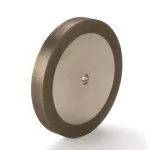Basic Introduction to Grinding Wheels
A grinding wheel is a tool used in the abrasive machining process to shape and finish surfaces. It consists of abrasive particles bonded together by various materials, forming a solid circular shape. Grinding wheels are widely used in industries such as manufacturing, construction, and metalworking.
The composition of a grinding wheel determines its performance and suitability for different applications. The abrasive particles can be made of various materials, including aluminum oxide, silicon carbide, and diamond. Aluminum oxide is the most commonly used abrasive material due to its versatility and affordability. Silicon carbide is harder and more brittle, making it suitable for grinding hard materials. Diamond, being the hardest material known, is used for precision grinding and cutting applications.
The bonding material holds the abrasive particles together and provides structure to the grinding wheel. Common bonding materials include vitrified bonds, resin bonds, and rubber bonds. Vitrified bonds are made from a mixture of clay, feldspar, and glass, and are known for their excellent strength and rigidity. Resin bonds are made from synthetic resins and are flexible, offering better shock absorption. Rubber bonds are softer and provide a smoother grinding action.
Grinding wheels come in different shapes and sizes to accommodate various grinding operations. The shape of the wheel determines the type of work it can perform. Some common wheel shapes include straight, cylinder, tapered, and dish. Straight wheels are the most common and are used for surface grinding and snagging operations. Cylinder wheels are used for grinding cylindrical surfaces. Tapered wheels are used for gear teeth grinding and other intricate tasks. Dish wheels have a concave shape and are useful for grinding on curved surfaces.
The size of the grinding wheel is specified by its diameter and thickness. The diameter represents the wheel’s outer circumference, while the thickness indicates the width of the wheel. These dimensions are crucial for achieving desired results and maintaining safety during grinding operations. It is important to choose the right size of the grinding wheel based on the machine’s specifications and the intended application.
When using a grinding wheel, it is essential to adhere to safety guidelines to prevent accidents and injuries. Always wear appropriate personal protective equipment, such as safety glasses, face shields, and gloves. Ensure that the grinding wheel is properly mounted and securely fastened to the machine. Regularly inspect the wheel for any cracks or damage before use. Maintain a safe distance from the rotating wheel and avoid applying excessive pressure, as this can cause the wheel to break.
In conclusion, grinding wheels are essential tools in various industries for shaping and finishing surfaces. Understanding the composition, shape, and size of grinding wheels is crucial for selecting the right wheel for specific applications. Following safety precautions when using grinding wheels is essential to ensure the well-being of operators and maintain efficient grinding operations.
.webp)





